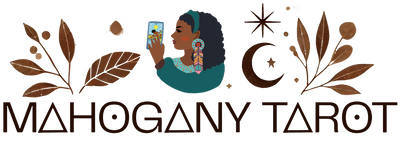
For centuries, people have sought ways to connect with the wisdom of their ancestors, a spiritual lineage often hidden beneath layers of modern life. Tarot, a tool of divination with European roots, has become a vessel for this connection, transcending its origin to resonate with people of diverse cultures. In the hands of Black and indigenous mystics, tarot transforms into something deeply personal: a way to honor lineage, reclaim suppressed traditions, and listen to the voices of those who came before.
Ancestral Connection: A Timeless Practice
In many African and indigenous traditions, the belief in ancestral presence is foundational. Ancestors are more than memories—they are guides, protectors, and reservoirs of strength. While tarot may not be native to these traditions, its archetypes and storytelling qualities echo the ancestral practices of consulting spiritual figures for guidance.
For example:
- In West African cultures, divination methods like Ifá and the use of kola nuts connect practitioners to the Orisha and their ancestors. These practices are centered on asking and interpreting questions much like tarot spreads.
- In indigenous North American traditions, elders often used symbols found in nature, stars, animals, and even the direction of winds, to interpret spiritual messages and understand life’s cycles.
By integrating the symbolism of tarot into these deeply rooted practices, we open a door to self-discovery that’s aligned with both personal and collective heritage.

Symbols and Archetypes as Ancestral Mirrors
One of tarot’s most compelling aspects is its ability to reflect universal truths through archetypes. The Major Arcana cards, for example, are steeped in themes that resonate with ancestral reverence:
- The Hermit: A guide and wisdom-keeper, mirroring the role of an elder in indigenous cultures.
- The High Priestess: The spiritual matriarch, bridging the physical and mystical worlds.
- The Tower: A card of destruction and renewal, echoing the cycles of life and nature emphasized in indigenous teachings.
These archetypes can serve as portals to ancestral connection, encouraging you to reflect on your lineage, strengths, and the guidance your ancestors offer.

Reviving Lost Traditions Through Tarot
For Black mystics, the act of using tarot can become a reclamation of spiritual practices that colonization and systemic oppression sought to erase. While the cards themselves may not originate in Africa or the Americas, their use can complement traditional practices like:
- Hoodoo candle rituals: Combining tarot insights with the ritualistic use of candles and herbs to amplify intentions.
- Nature-based meditations: Drawing tarot cards outdoors, surrounded by the elements, to connect with the earth and the spirits that inhabit it.
Each reading becomes more than a search for answers; it becomes an act of resistance, a way to honor and rebuild a cultural legacy.
Creating Rituals for Ancestral Connection
Tarot is most powerful when approached as part of a sacred ritual. Here’s how you can incorporate it into your practice to connect with your ancestors:
-
Prepare Your Space: Set the scene with objects that represent your lineage, family photos, heirlooms, or items that hold cultural significance. Use incense or herbs like frankincense, sage, or sweetgrass to purify the area.
-
Ground and Invite: Before drawing cards, take a moment to meditate. Speak to your ancestors as if they were in the room, saying something like, “I call upon the wisdom of my ancestors to guide me in this reading.”
-
Ask Intentionally: Formulate questions that align with your connection to your heritage. For example:
- “How can I honor my lineage in this chapter of my life?”
- “What lessons from my ancestors should I carry forward?”
-
Interpreting the Cards: As you read the cards, pay special attention to symbols that remind you of your heritage or family stories. Journaling your insights can help you deepen your connection over time.
-
Close with Gratitude: Conclude by thanking your ancestors for their guidance, lighting a candle in their honor, or leaving a small offering like water or fruit on an altar.
Lessons from Indigenous Practices
Indigenous spirituality often teaches that ancestors aren’t just behind us, they walk with us. This understanding can shift how we see tarot: not as a predictor of the future but as a way to connect to the continuum of time, where past, present, and future converge.
In some indigenous traditions:
- Dreamwork plays a major role in ancestral connection. Combining tarot readings with dream journaling can enhance your ability to understand messages from the spiritual realm.
- Vision Quests are used to seek clarity and guidance. A similar approach can be taken by dedicating a full day to meditation, reflection, and tarot readings.
By weaving these practices into your tarot work, you create a richer, more holistic connection to your roots.
Empowering Modern Mystics
The resurgence of tarot among Black and indigenous practitioners signals a powerful reclamation of spiritual authority. It’s not just about seeking answers, it’s about standing tall in your heritage, embracing your identity, and using the tools at your disposal to create a future that honors the past.
Whether you’re drawing cards for guidance, grounding yourself in ancestral energy, or pairing tarot with cultural rituals, remember: your practice is valid, powerful, and deeply personal. Tarot isn’t just about the cards you pull, it’s about the journey they take you on.
Final Thoughts
Your ancestors’ wisdom lives within you, waiting to be unlocked. Tarot is one of many ways to access it, providing a modern lens through which to view ancient truths. By integrating tarot with your heritage, you step into a spiritual practice that’s as unique as your own story.
So, light a candle, shuffle the cards, and take the time to listen. The answers are already within you, carried on the voices of those who walked before.
